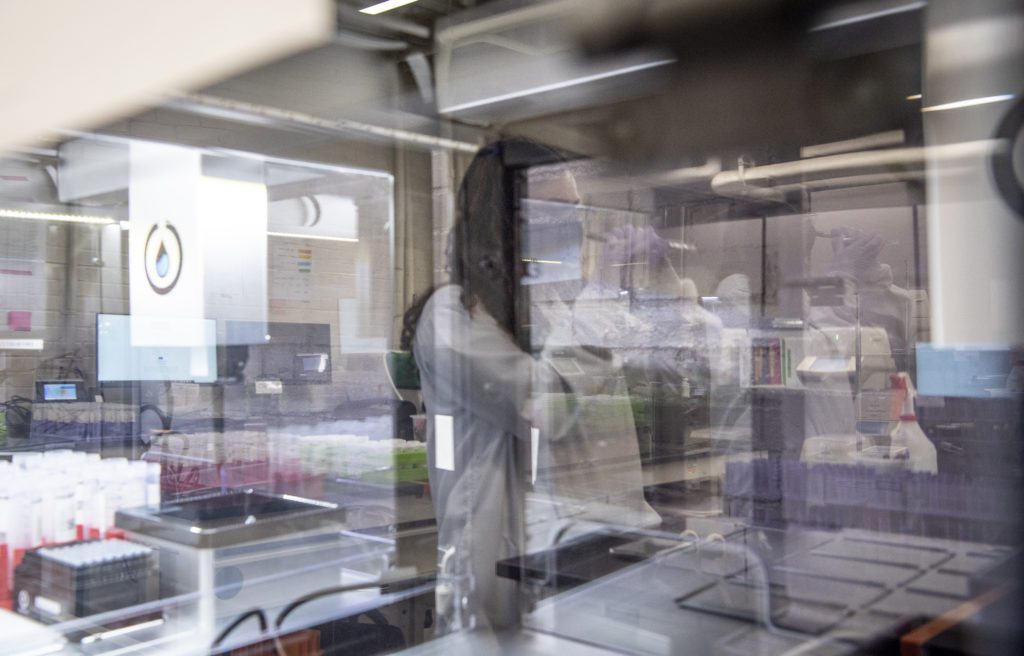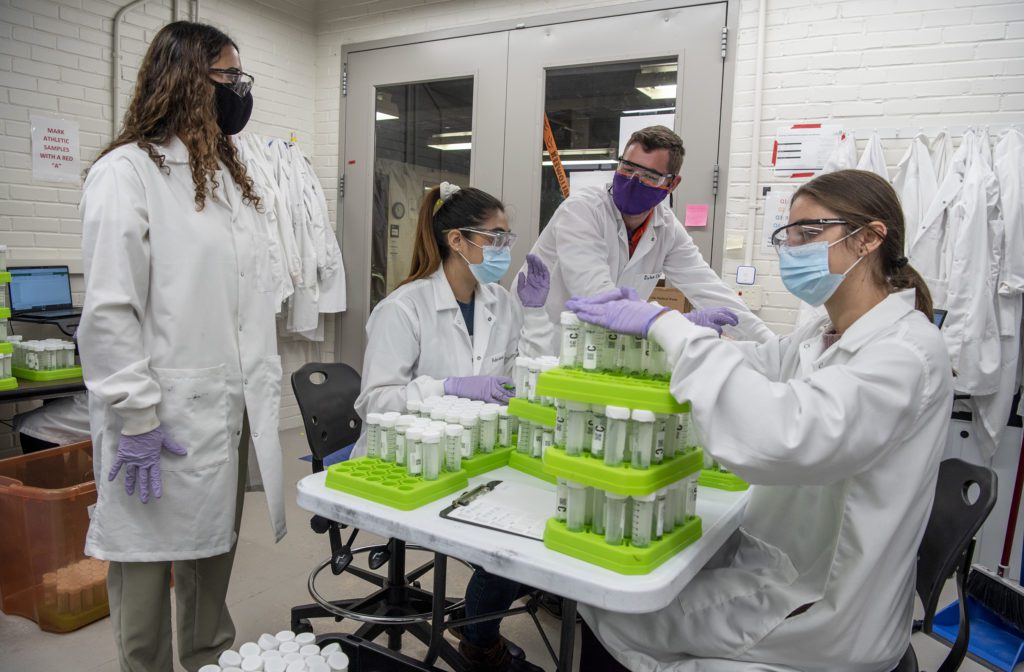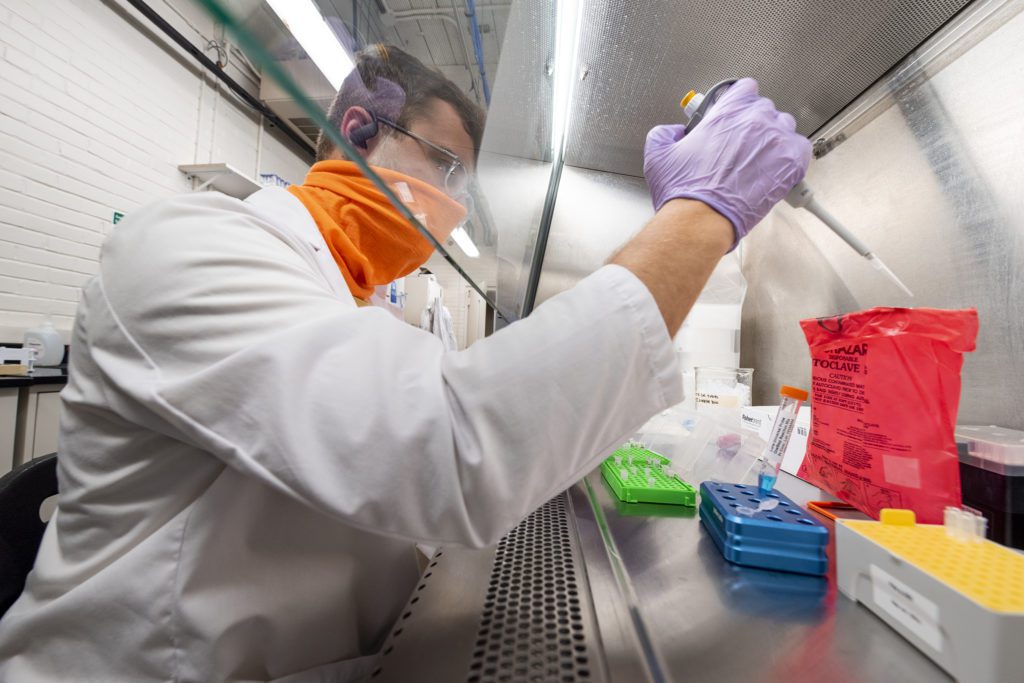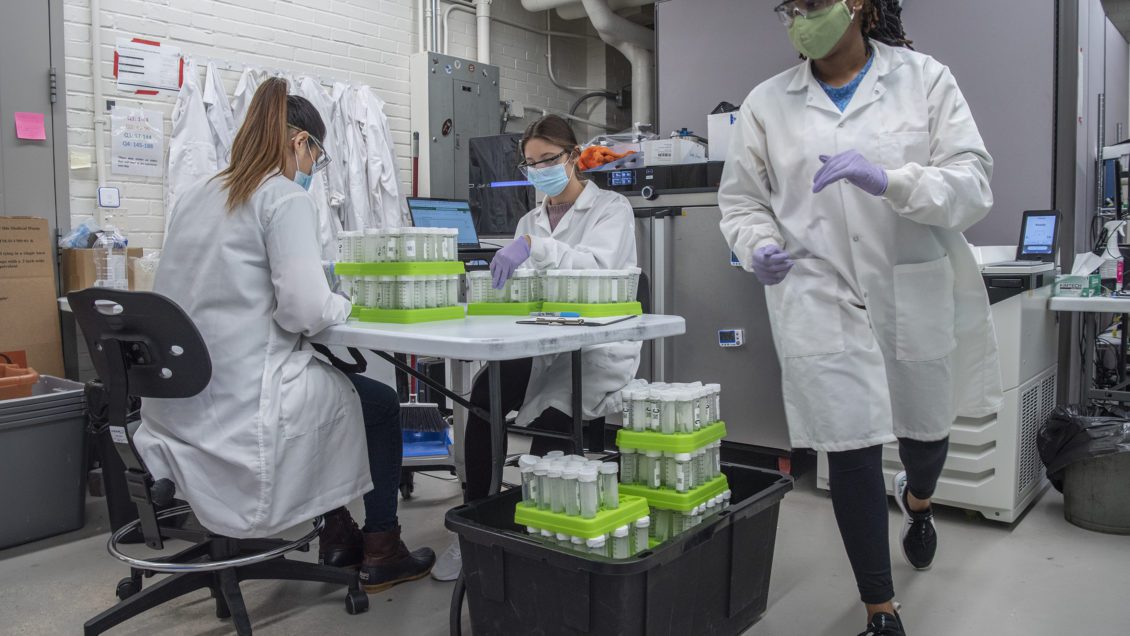The faculty, staff and students who run Clemson University’s groundbreaking COVID-19 testing lab didn’t hold a party to celebrate its birthday. Instead, they did what they do every day — add a few thousand to the more than 585,000 samples they’ve tested in the lab’s first year.
In the span of 12 months, the Clemson University Research and Education in Disease Diagnosis and Intervention (REDDI) Lab has grown from a modest internal operation to one that epitomizes the University’s land-grant mission. At first offering testing exclusively to Clemson faculty, staff and students, the lab scaled up to serve the greater Upstate community and, at the same time, has continued to provide invaluable real-world experience to dozens of Clemson’s health care, bioengineering and computer science students.
The REDDI lab started with a testing capacity of 200 daily tests in September 2020 and now has the capacity to do 9,000 saliva tests per day. This expansion, funded through a $6.9M commitment from the state of South Carolina, includes free testing for anyone in the greater Clemson area. Today the lab employs 60 undergraduate and 30 graduate students majoring in multiple disciplines from nursing to computer engineering. They work alongside nationally respected bioengineering and health care faculty and full-time employees.

“Whether you’re in public health, bioengineering, or whatever field you’re majoring in, this is real life,” said Jesse Boulos, a bioengineering graduate student, as she loaded trays of sample tubes into one of the open-source robots lined up in the lab. “We’re using our knowledge to make a real difference in the fight against [COVID-19] and that’s very fulfilling.”
Dylan Chitwood, a third-year doctoral bioengineering student who was working alongside Boulos, said working in the REDDI lab has added greatly to his college experience in the year he’s been doing it, but the most value has been in the life experience.
“It’s most definitely been good for me. I want to do biopharmaceuticals when I graduate so it’s extremely useful to have experience in a high throughput clinical setting – but it’s also just good to feel like you’re contributing as part of the solution to keep your community safe.”
The robots Chitwood and Boulos were using have been key to the lab’s efficiency, said lab supervisor Rachel Ham, who originally came on to the project as a research tech.
“Developing a system is paramount to success and using automation has been a big part of that for us,” she said. “We’ve used these relatively affordable robots to help us do a lot of these repetitive tasks. Our open-source robots cost about $20,000—they’re similar to a 3D printer. A typical lab sample robot for a typical high throughput lab is half a million dollars.”
As the COVID-19 pandemic began its rapid spread into all corners of the Earth— and public health experts and administration officials realized the University needed a way to monitor and screen for the spread of the virus— efficiency and affordability were critical to success as the REDDI lab was launched. A group of researchers led by bioengineering professor Delphine Dean quickly devised a system to test people using the “swab” (nasopharyngeal) method and set up drive-through testing stations at several locations close to campus. On campus, the REDDI laboratory was built from the ground up in a matter of weeks to test the samples and return the results in less than a day’s time.

Soon after that, Dean and her team devised a much easier test that only requires the person to put a small amount of saliva in a tube. They named it the TigerSaliva test, one of the first of its kind in the nation, and it greatly reduced money and manpower because there is no need for a trained professional to take the sample, which also reduces the need for personal protective equipment. The cost savings continue at the lab because saliva samples require fewer steps to extract RNA from the virus than nasal swabs. The REDDI lab’s method soon became the gold standard for COVID-19 testing.
Dean emphasizes that another key to the REDDI lab’s success has been the cooperation between the many different areas of the University, including colleges, divisions, centers, offices, foundations, boards, institutes, committees and more. She says people immediately came together across the board to support the lab’s mission.
“How does COVID spread? It spreads through spit,” said Dean. “In March of 2020, I was on a statewide task force with a bunch of people from universities all over South Carolina. We worked with the University of South Carolina to start validating this kind of saliva test because doing the nasal swabs was not fun, and they were expensive. Plus, you needed a person who knows what they’re doing to administer it. So, we did some testing and got over 2,000 samples from people getting the nasal swab who also spit in a tube for us. We thought COVID was an upper respiratory disease but now we know that it’s an everywhere disease.”

Dean said the goal of the REDDI lab has quickly evolved from being a testing site for Clemson to a full-on research operation that could have national and even global impact. Collaboration has been the key to the lab’s success, with the greater Clemson community being no small part of it.
“People might not know – once you have a positive test, you have to have a follow-up call from a medical professional,” said Dean. “They will call and tell you you’re positive, you need to isolate, and do you have any questions? University students get called by Redfern, faculty and staff get called by the Sullivan Center, but when we started wanting to do community outreach, the University didn’t have the resources to do the calls. So, a Rockstar group of doctors in our community volunteered their time. It’s not necessarily their patients either – so it’s a huge ask.”
Dean said that, to this day, they are still posting hundreds of positives every week, and local doctors continue to make those difficult calls.
“I think this is a good example of Clemson and the community working well together. Other schools that have labs haven’t been able to expand to community testing because they don’t have that – but we do, and that’s what makes this place so special.”

